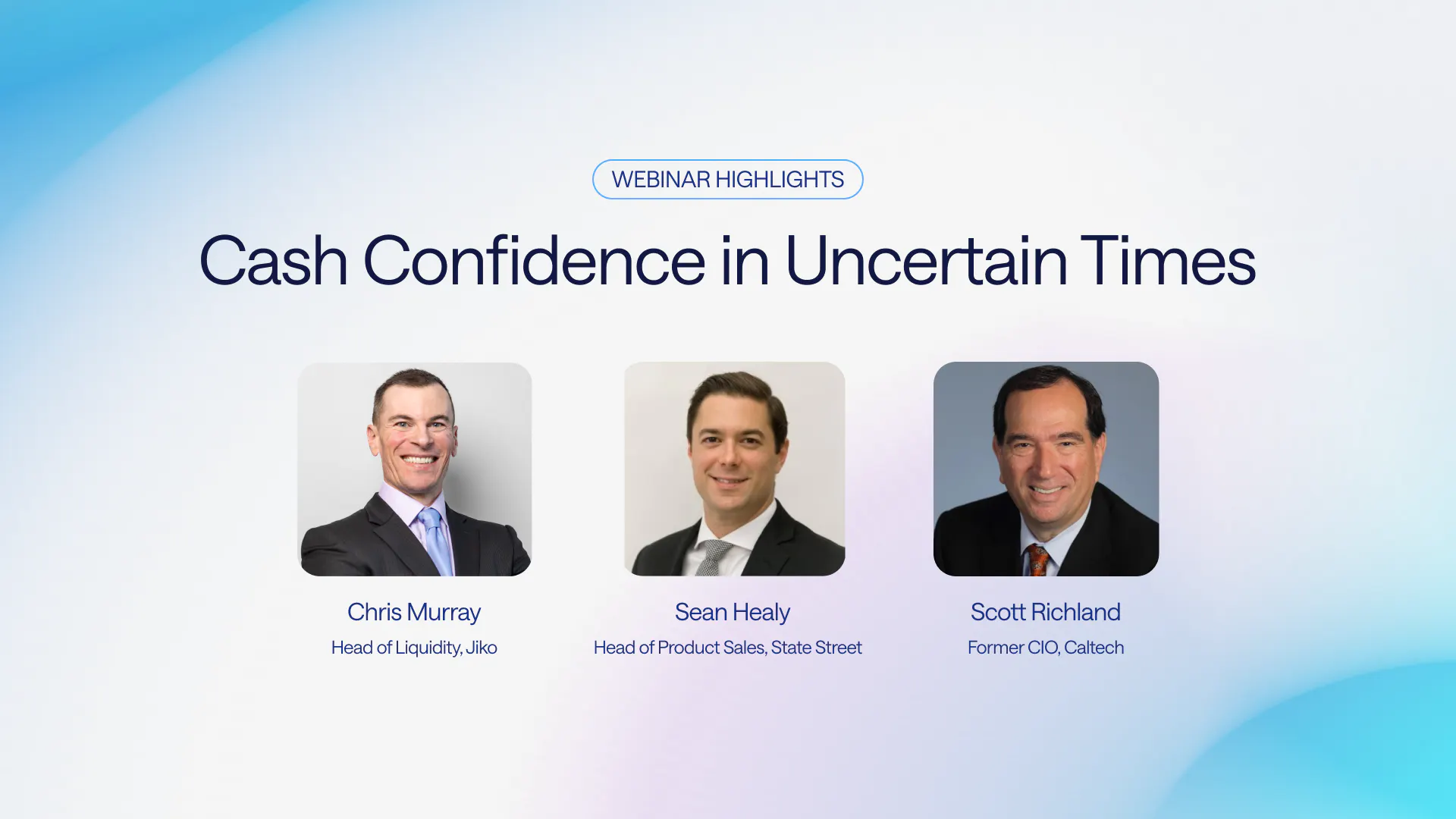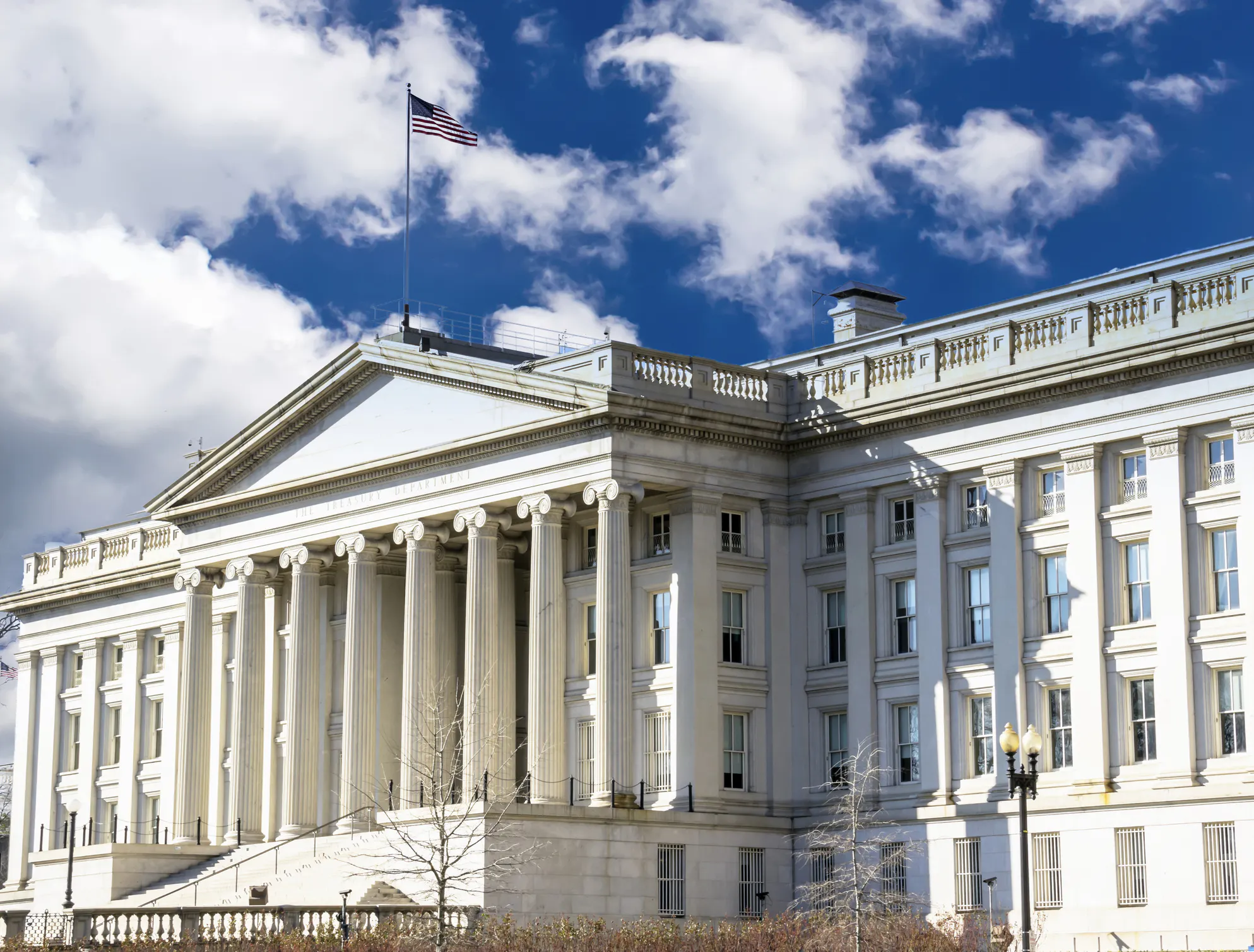A Guide to Properly Evaluating Money Market Funds Before Allocating Corporate Cash
Money Market Funds (MMFs) are one of the most widely used tools for managing short-term cash while earning short-term yield, but not all MMFs are created equal. With varying fund types, investment strategies, and levels of credit exposure, it’s critical to evaluate each option carefully. Treasurers need to ensure the fund they choose aligns with their organization’s cash strategy, risk tolerance, and operational needs. This guide outlines a structured approach to help you do just that.

According to our 2025 Corporate Cash Confidence Survey, only 16% of finance professionals say they regularly monitor the underlying assets of their MMFs. When allocating large volumes to short-term instruments, the margin for error can be razor-thin. Choosing the wrong Money Market Fund (MMF) isn’t just a missed opportunity for yield; it could increase the risk of delayed access to funds during periods of market stress.
To unpack these risks, we brought together experienced treasury leaders in our recent webinar, Cash Confidence in Uncertain Times, where they shared how to evaluate MMFs and other common instruments, navigate risks, and prepare their cash strategies for crisis scenarios.
This guide draws directly from insights shared by finance leaders who navigated the 2008 and 2023 crises during our recent webinar to walk treasurers through a structured approach to evaluating MMFs before making an investment decision.
Choosing a Money Market Fund
Before evaluating fund performance or fees, it’s critical to understand how MMFs are structured and where the risks come from.
MMFs pool capital from many investors and allocate it across a portfolio of short-term instruments like commercial paper, repurchase agreements (repos), and Treasury securities. When you invest in an MMF, you’re not buying the underlying securities directly. Instead, you own shares in the fund itself, which is actively managed and subject to liquidity policies, redemption terms, and regulatory requirements.
In stable market conditions, many MMFs offer same-day liquidity and relatively low volatility with modest returns. But during times of stress, counterparty risks introduced by the pooled fund structure can lead to liquidity issues. In scenarios where redemptions spike dramatically or if counterparties fail to perform, investors may face unexpected delays or redemption fees when trying to access their cash.
Even seemingly conservative government and treasury MMFs may hold repo agreements, which rely on counterparties returning collateral on time. If one fails or enters bankruptcy, the legal process to recover collateral could delay access to cash when it's needed most.
This dynamic became painfully clear in 2008 when the Primary Reserve Fund “broke the buck.” The fund had minimal exposure to Lehman Brothers when it collapsed, but still saw a wave of redemptions that ultimately forced it to break the buck. As discussed in the webinar, the collapse of a single issuer led to broad contagion, freezing access to cash and triggering a liquidation process that took years to resolve.
In short, MMFs have historically exhibited low volatility, but during periods of market volatility, their commingled structure introduces counterparty exposure and liquidity risk. It's precisely in those moments when safety and access matter most that the structure of the fund can become a constraint.
MMFs come in various types, each with different risk profiles and investment strategies. As a treasurer evaluating MMFs, it is important to understand the risks associated with each fund before investing.
Prime Money Market Funds
Prime MMFs invest in a broader range of short-term, relatively low-risk debt instruments, including commercial paper, certificates of deposit, and repurchase agreements. Because they hold corporate-issued securities, they carry more credit and liquidity risk than Government or Treasury MMFs.
As noted in the webinar, a growing trend is the declining use of prime funds by institutional and commercial investors. These investors are increasingly gravitating toward government and Treasury MMFs instead, in part due to evolving risk appetites and operational policies. Prime funds today are more heavily used by retail investors, and that shift has shaped how fund managers position their portfolios.
Government Money Market Funds
Government MMFs primarily invest in U.S. government securities, including Treasury bills (T-bills) and government-backed repos. These funds are generally considered lower risk than prime MMFs because their holdings are backed by the U.S. government or issued by government-sponsored entities, and thus, typically yield less than prime funds.
Treasury Money Market Funds
Treasury MMFs take the conservative approach one step further by investing almost exclusively (at least 99.5%) in U.S. Treasury bills, notes, and bonds. These funds are often the most resilient and may offer preferential treatment under certain regulatory frameworks.
While it’s easy to assume these fund types offer meaningfully different returns, that’s not always the case. As pointed out in the webinar, the yield difference between Government and Treasury MMFs is often negligible, especially when weighed against the potential reduction in credit and counterparty risk.
Once the choice is made, the next step is to evaluate the fund-specific details.
Before diving into the holdings or past performance of a MMF, and when prioritizing safety in the decision, it’s important to take stock of its overall size and investor composition.
Smaller funds may be more sensitive to large shareholder redemptions. Why? Because when a large redemption occurs in a relatively small fund, managers may be forced to sell the most liquid assets first to meet those requests. That can leave remaining investors with a portfolio of longer-term or less liquid assets, which may reduce flexibility and impact returns. If redemptions continue, the fund may have limited tools to manage outflows without triggering broader liquidity issues.
While size alone isn’t a guarantee of stability, larger and more diversified MMFs tend to be better equipped to handle volatility. Treasurers should also pay attention to cash flow trends: sudden spikes in inflows or outflows could be a sign of changing investor sentiment or risk posture within the fund.
Once treasurers decide on the type of MMF and size they are comfortable with, most treasurers begin comparing yields as the next step. While past performance is not a guarantee of future results, it offers valuable insights into how a fund has performed historically and responded to different economic conditions.
Treasurers should review yield trends over multiple interest rate cycles to understand how returns fluctuate under different scenarios. An easy way to do this is to compare a specific MMF’s historical returns against the average performance of Government MMFs.
A well-managed fund should demonstrate consistent performance and strong liquidity management across different market conditions. This data is typically available in the fund’s prospectus, fact sheets, and regulatory filings, or through fund manager portals and third-party data platforms.
Gross yield only tells part of the story. To understand true return, treasurers also need to account for fees, which can quietly erode performance, especially in low-rate environments.
Each MMF is required to disclose its expense ratio, which represents the annual percentage of assets deducted for fund management. Comparing expense ratios across similar funds allows treasurers to determine whether the fees are justified by performance and risk management. Several categories make up the total fees for a MMF.
Management Fees
This is the fee paid to the investment adviser for managing the portfolio. It’s typically a percentage of the assets under management and is the primary cost reflected in the fund’s annual expense ratio.
12b-1 Fees
Although not as common in MMFs, some funds may include a small fee for marketing and distribution expenses. These fees, when charged, are also part of the overall expense ratio.
Redemption Fees
Some funds charge a fee when investors redeem their shares, particularly if they do so within a short holding period or when there is significant outflow from the fund. In 2023, the SEC reformed rules to “address concerns about redemption costs and liquidity… The amendments will require institutional prime and institutional tax-exempt Money Market Funds to impose liquidity fees when a fund experiences daily net redemptions that exceed 5 percent of net assets, unless the fund’s liquidity costs are de minimis. In addition, the amendments will require any non-government money market fund to impose a discretionary liquidity fee if the board determines that a fee is in the best interest of the fund.” Effectively, in scenarios where enough shareholders liquidate, any further redemptions after that threshold bear the costs suffered by the fund to liquidate in stressed markets. Redemption fees are safeguards to prevent liquidity issues.
Administrative and Operating Expenses:
These cover costs such as recordkeeping, custodial services, accounting, and regulatory compliance. Like management fees, they’re usually bundled into the overall expense ratio.
Other Expenses
There can be additional minor expenses related to legal services, audits, and other operational costs. Examples of such fees include:
Brokerage Commissions: A fee paid each time a trade is executed. Some brokers charge per trade, while others offer commission-free trades.
Transaction Fees: Fees imposed by intermediaries for processing the purchase or sale of fund shares.
The cost of these fees can vary, and understanding these fees is essential, as they can impact the net return on an MMF investment. Treasurers should review fund disclosures and fee structures carefully to ensure they align with their organization's financial objectives and cash management strategy.
There are two levels of counterparty risk associated with a MMF. The first and more obvious one is the creditworthiness and reputation of the fund manager itself.
Treasurers should examine the financial strength and credibility of the institution offering the fund. A well-established fund manager with a long history of successfully navigating liquidity crises provides a level of security that newer or lesser-known managers may not. Reviewing the fund manager’s track record, particularly during times of market stress, is essential. Treasurers should verify that the fund complies with the diversification, liquidity, and operational requirements set forth in SEC Rule 2a-7, which governs MMFs.
While brand recognition often serves as a quick reference point, treasurers should look beyond the name. Key details can typically be found in the fund’s prospectus, regulatory filings, and public financial statements. Industry ratings from agencies such as Moody’s, S&P, and Fitch also offer helpful benchmarks for assessing a manager’s credibility. Many fund providers supplement this with performance reports and investor communications that highlight how they’ve navigated past periods of volatility. Taken together, these sources help treasurers evaluate whether a fund manager has the experience and discipline to safeguard corporate cash through both calm and crisis.
The second level of evaluation is the actual underlying securities and counterparty exposures within the portfolio. This is an important step that can require a detailed review of holdings to understand where risk may be hiding.
Even within Government or Treasury MMFs, which are typically viewed as conservative, there can be exposure to counterparties through instruments like repos, which rely on counterparties to fulfill their obligations, introducing credit and liquidity risks that aren’t always obvious on the surface.
To assess these risks, treasurers should review the fund’s financial statements, which typically include a detailed list of underlying assets along with information such as yield, maturity date, face amount, market value, and asset category.
Conclusion
Choosing the right Money Market Fund isn’t just about finding a high yield. It requires a well-informed decision that aligns with your organization’s risk tolerance, liquidity needs, and operational goals. That means looking beyond the label and carefully examining the fund’s structure, size, performance, cost, manager credibility, and underlying holdings.
In periods of market calm, a deep evaluation of these factors may seem unnecessary. But when volatility strikes, the details matter. Poorly understood risks can become immediate problems—locking up access to cash or introducing exposures you didn’t anticipate. That’s why it’s essential to build discipline into the evaluation process before a crisis unfolds.
Many of the risks touched on in this article stem from the pooled structure of MMFs, where commingled assets and redemption mechanics can create challenges during times of market stress. For treasurers seeking more direct control, one alternative is to avoid the pooled model altogether and invest directly in the underlying securities. That is the approach Jiko enables—providing direct, liquid access to U.S. Treasury bills, held in the client's name.
In a market where confidence can shift quickly and liquidity remains a top priority, building a transparent and reliable cash strategy is crucial.
Further reading

Watch Now: Industry Veterans on Corporate Cash Confidence in Uncertain Times
Jiko's latest webinar roundtable discussion, now available on-demand in a 'key highlights' format, features treasury leaders' insights about commonly used cash instruments, key risks to watch for, and practical ways to evaluate safety and liquidity.. Read more →

How Treasury Bills and Money Market Funds React to Falling Interest Rates
The Federal Reserve adjusts interest rates as a primary tool to manage inflation, support economic growth, and maintain financial stability. Read more →

Understanding the Fundamentals of Treasury Bills: A Comprehensive Guide
Treasury bills (T-bills) are a cornerstone for cash management, providing security and predictable returns backed by the U.S. government. From individuals to large institutions, investors of all sizes rely on T-bills to preserve capital and maintain liquidity in any economic environment. This guide explores the fundamentals of T-bills, including how they work, how they compare to other investments, and how they fit into an overall investment or cash management strategy.. Read more →